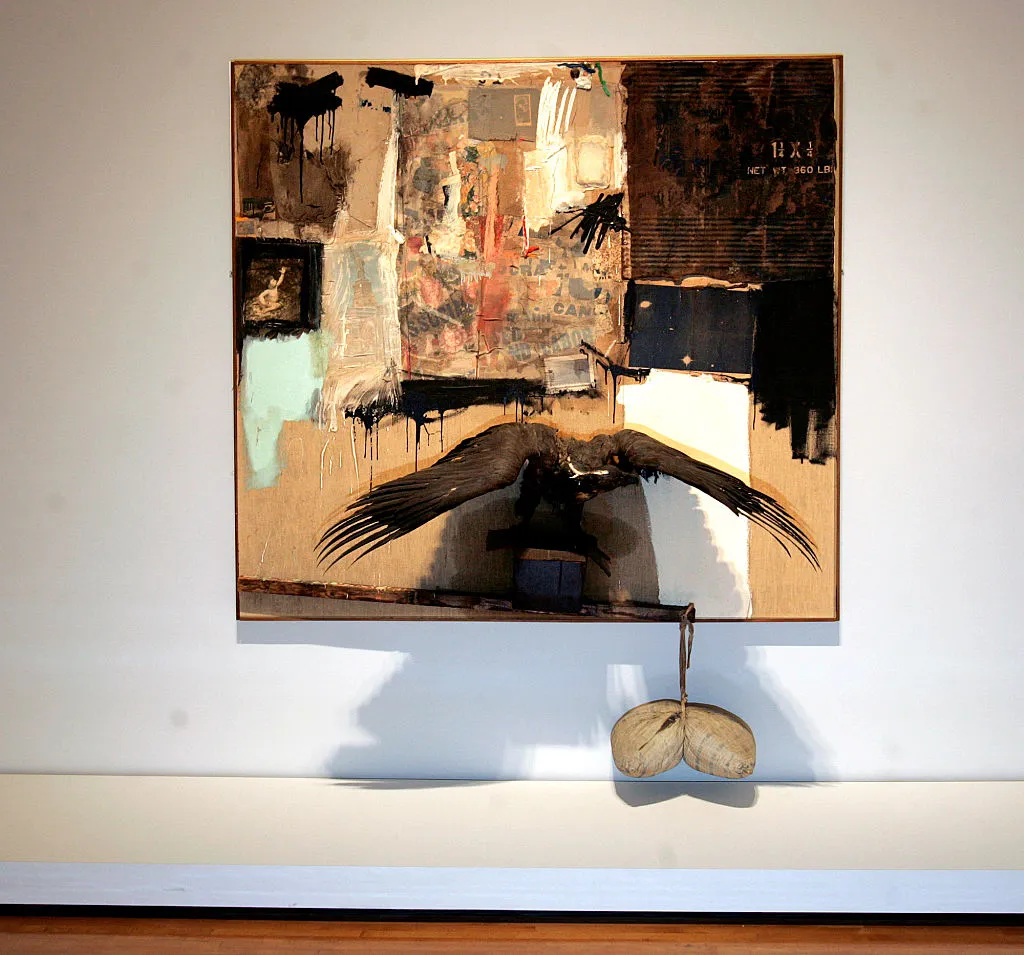By Daniel Grant
Copyright observer

When art gallery owner Ileana Sonnabend died in 2007 at age 92, she left behind a substantial collection of paintings and sculptures that, over the next eight years, was sold privately and at auction for over half a billion dollars. One artwork, however—a 1959 mixed-media collage titled Canyon by Robert Rauschenberg—was not sold, because U.S. law forbade its sale. The work included a taxidermied bald eagle that the family of a friend of the artist had thrown out after he died, which Rauschenberg chose to incorporate into his painting. But the Bald and Golden Eagle Protection Act prohibits the killing, “possession, sale, purchase, barter, offer to sell, purchase or barter, transport, export or import, of any bald or golden eagle, alive or dead, including any part, nest, or egg, unless allowed by permit.”
The artwork could not be sold, and the Sonnabend family listed its value at zero. The Internal Revenue Service, however, claimed that—based on comparable Rauschenbergs—Canyon should be valued at $65 million and demanded the estate pay a tax of $29.2 million plus $11.7 million in penalties.
“It’s ridiculous,” Ralph Lerner, the tax lawyer who represented the family in its contest with the IRS, told Observer. “How can you have a qualified appraisal of something that isn’t allowed to be sold?” Eventually, a Solomon-like solution was negotiated in 2012: the artwork was donated to the Museum of Modern Art in New York, no charitable deduction was claimed by the heirs and no taxes or penalties were paid to the IRS.
It’s a rare situation, but one that arises from time to time—something that once cost a fortune is now worth nothing, simply because it can’t be sold. This can apply to a range of objects, including most ivory (such as carved scrimshaw), tortoise shells, protected animal horns or artworks with questionable provenance—like antiquities potentially looted from Asian temples, Egyptian burial sites, Native American reservations or tribal regions in African nations, as well as what is commonly referred to as “Holocaust art,” or artworks stolen from Jewish collectors by the Nazis.
What to do with biological specimens
Selling individual items or entire curio collections may be legally impossible, leaving owners with few options beyond bequeathing them to heirs or donating them to museums. These may sound like solutions, but they often aren’t. Heirs might not want the objects—or the legal headache that comes with them. Museums may reject such gifts to avoid criticism or potential lawsuits. “You have to consider the legal restrictions of marketability when doing estate planning,” said New York lawyer William Pearlstein, referring to one client’s $10 million collection of antique ivory acquired during the 1970s and 1980s—none of it documented as to age or origin. “The heirs came to us, wondering what they could do.”
His advice: “Undocumented items are not marketable, and I think they wrote it down to zero.” He added, “We never heard back from them,” so he assumed the IRS accepted that position. (A spokesperson for the IRS declined to confirm what its typical practices are in such cases.)
Ivory laws are strict because the goal is to shut down the market entirely and stop the poaching of African and Asian elephants, which are listed as threatened and endangered species, respectively, under the U.S. Endangered Species Act. Only certain ivory items can be sold. Federal regulations established by the U.S. Fish and Wildlife Service—an agency within the Department of the Interior—permit the interstate sale of ivory only if the object is an antique (over 100 years old), has not been altered since before December 27, 1973, or is a musical instrument, firearm or piece of furniture containing less than 200 grams of ivory.
All of this requires documentation, although exactly what constitutes acceptable proof isn’t always clear. A dated government permit from the country of origin, a pre-ban photograph of the item, a will, a sworn statement or even a letter from a relative mentioning the object could suffice, but the burden of proof falls on the seller to demonstrate that the ivory meets one of these exceptions.
There are state, federal and international laws regulating the trade in endangered species. Judith Wallace, a partner at the New York law firm Carter Ledyard & Milburn, advises clients to consider all applicable jurisdictions “before transferring or transporting any item, but also in the planning stages so that they can understand whether a collection has value” and in “assembling the correct documentation.”
Many owners lack such documentation. An ivory object may indeed be over 100 years old, but without clear records—like a diary entry, photograph or detailed receipt—it may be legally unsellable. Further complicating matters, most owners don’t know the species of origin. That matters, because different laws govern the sale of ivory from elephants, walruses, whales, hippos and warthogs across state and national borders.
Without documentation, you may legally own an object, but selling is out of the question—and museums with strict acquisition policies likely won’t take it either.
One path forward is scientific testing. Owners can commission DNA testing to identify species or carbon dating to determine an item’s age. State universities typically offer these services, with prices ranging from a few hundred dollars for species testing to $500-750 for carbon dating. However, the Center for Conservation Biology at the University of Washington refuses to conduct such tests. “It serves to promote a trade that is helping animals become extinct,” said director Samuel Wasser. “I think the best thing to do with ivory is to just destroy it.”
Destruction is, in fact, the option some owners choose. The U.S. Fish and Wildlife Service periodically hosts public “ivory destruction events.” Since ivory does not burn easily, it is usually crushed.
What to do with looted and banned objects
When it comes to antiquities and other cultural property, a broader set of laws may apply—especially the 1970 UNESCO treaty, which seeks not to destroy but to return looted or illegally exported items to their country of origin. Unlike ivory or scrimshaw, which owners may legally retain even if unsellable, antiquities can be seized by the government if proven to have been stolen. In such cases, the title remains with the country of origin. The burden of proof rests with the government to show that an object was imported illegally.
If cultural property is seized—such as by U.S. Customs—taxpayers cannot claim a loss, since the objects were never lawfully theirs. Buyers may also face criminal charges if they made false statements about the items when importing them.
Selling questionable objects can be a moral and legal gray zone. “Reputable auction houses and galleries are absolutely reluctant to handle anything with questionable provenance,” Nicholas M. O’Donnell, a partner at the Boston-based law firm Sullivan & Worcester, told Observer. “Certainly, Sotheby’s and Christie’s restitution research departments are exemplary, and every lot they sell is examined with that in mind.” Still, the Art & Antique Dealers League of America challenged a New York State law that is stricter than federal regulations, defending the trade in dead endangered species to the extent it remains legal. And Lerner noted, “Dealers may handle consignments of this type if they think a possible legal claim is remote.”
One potential remedy, according to Lerner, is to file an “action to clear title”—a lawsuit that forces another party to prove you do not have legal ownership. The challenge is figuring out whom to sue.
Museum donation isn’t a catch-all fix
Whether a museum accepts a donation of an undocumented object often depends on the institution. In its 2013 “Guidelines on the Acquisition of Archaeological Material and Ancient Art,” the Association of Art Museum Directors acknowledged how difficult it can be to verify recent provenance and affirmed that “museums should have the right to exercise their institutional responsibility to make informed and defensible judgments.” The association also maintains an antiquities registry where member museums are encouraged to post newly acquired items lacking documentation.
“The Museum of Modern Art really wanted that Rauschenberg,” said Lerner. Donating such works can offer more than one benefit. “Since donation of such problematic works to a museum or other charitable institution means that their purported market value is not included in calculating the estate’s overall value—and thus the estate tax owed—our advice is to donate the works in question,” Daniel H. Weiner, a partner at the New York law firm Hughes Hubbard & Reed, told Observer.
Wallace defended MoMA’s acceptance of Canyon, noting that “the Rauschenberg case highlights that artworks can have intrinsic artistic value, and I would also argue that the repulsion that one may feel upon seeing the taxidermied endangered species incorporated into the artwork is one of the many legitimate emotional responses to a complex artwork that justifies its public exhibition.”
Still, museums today often maintain strict policies barring the acquisition of undocumented antiquities. “Policies that may prohibit or restrict museum acquisition of antiquities that do not have proof of a pre-1970 provenance or proof of legal export from the country of origin,” explained Patty Gerstenblith, director of the Center for Art, Museum and Cultural Heritage Law at DePaul University College of Law.
There is also a stigma attached to owning problematic objects. The association with elephant poaching or temple looting can be embarrassing—and lawyers may leverage that shame to pressure settlements. “Especially if the owner is prominent,” Lerner said, “an allegation can be exploited.”
If a foreign government succeeds in reclaiming an object donated to a museum, the IRS does not rescind the charitable deduction claimed by the donor. “The government goes by the facts that are true on the date of the donation, and under the IRS regulations, the IRS is not supposed to use post-donation facts,” said Lerner. “Museums require donors to state that their donations are free and clear of any claims and liens, and unless the taxpayers intentionally misrepresented something, they should have nothing to fear.”
He may be more confident about that than the IRS, which, according to the spokesperson, evaluates such cases individually. The bottom line is that owning objects made from endangered species or looted artworks and antiquities sets the stage for years of legal complications. While an object may have once held great value, the most reasonable course when faced with a restitution claim may simply be to give it back.
More for art collectors
Record Prices, New Buyers and Global Reach: Design’s Moment Has Arrived
What’s Behind the Rise in Single-Owner Collection Sales
How New Perspectives Art Partners Plans to Reshape the High-End Art Market
From Dung to Dust, Unconventional Mediums Pose Challenges for Conservators and Collectors
The Art Market’s Ethics Illusion: Professional Associations Talk Standards But Offer Few Protections



